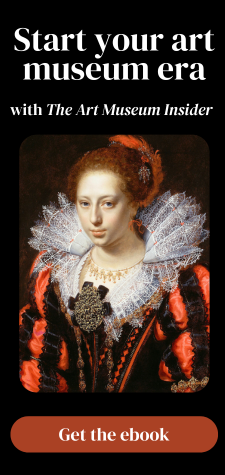Guest post by Aoife Brady, National Gallery of Ireland
In 1872, just eight years after first opening its doors, the National Gallery of Ireland (NGI) purchased The Visit of the Queen of Sheba to King Solomon by sixteenth-century virtuosa Lavinia Fontana. The painting was the first work by a female Old Master that was knowingly acquired by the National Gallery of Ireland. (I use the word knowingly here to distinguish it from our portrait of Prince Alessandro Farnese by Sofonisba Anguissola, which was purchased in 1864, but as a work by Alonso Sanchez Coello, later attributed correctly to Anguissola.)

A Crown Jewel in the NGI Collection
The painting was quickly recognised as one of the crown jewels of the Gallery’s collection, and has been on display more-or-less continuously for over 150 years. Extraordinarily detailed and widely recognised as the most ambitious composition that Fontana ever painted, the monumental canvas—measuring more than three metres, or almost ten feet, in width—has experienced a colourful and mysterious history since its creation over 400 years ago.
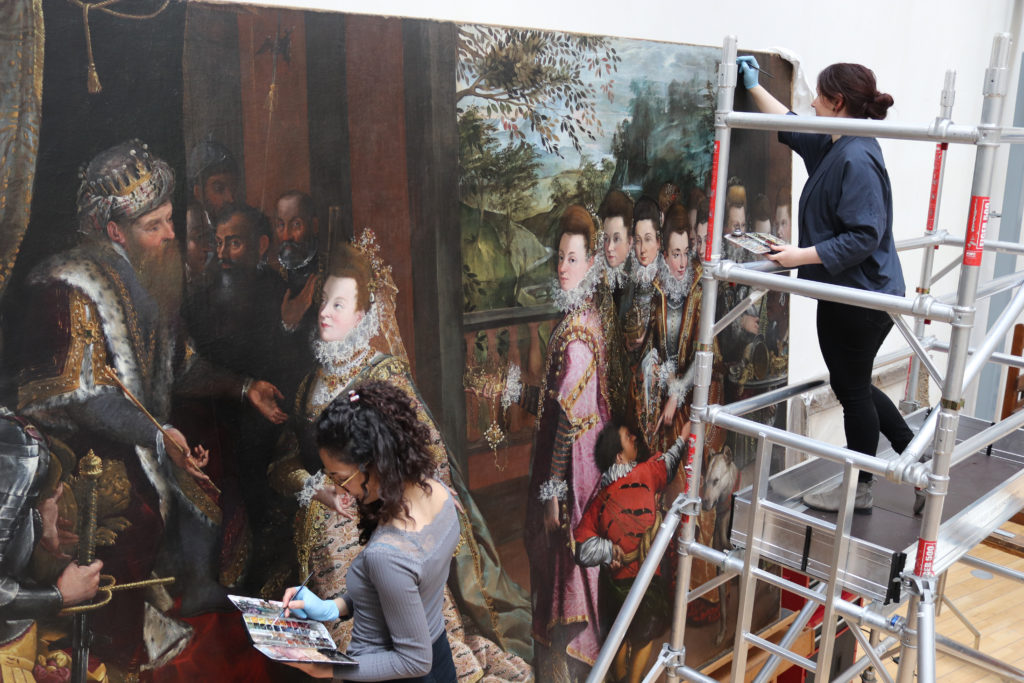
With the generous support of the Bank of America Art Conservation Project, the National Gallery of Ireland have been able to embark on an eighteen-month research and conservation project on this important work, exploring unanswered questions regarding the painting’s provenance and production, and restoring it to its former glory.
Many questions surround the origins and early life of the painting. It was recorded for the first time with certainty in the Palazzo Zambeccari in Bologna in the second half of the eighteenth century, but we have little information to determine to its whereabouts prior to that time. It was purchased via an intermediary by Prince Napoléon, first cousin of Napoleon III, in 1859, who brought it to Paris to join the rest of his collection in the Palais-Royal.
Alas, the painting’s Parisian sojourn lasted little over a decade. In 1871, during a period of political upheaval, the Palais-Royal was set alight during the suppression of the Paris Commune rebellion. The Visit of the Queen of Sheba to King Solomon was among a small number of paintings recovered from the fire. Its recovery attests to the value that must have been ascribed to the work at that time, since the painting’s enormous scale does not make it easily portable, and certainly did not lend itself to a straightforward evacuation from a burning building. From there, the painting travelled to London, where it underwent restoration and shortly thereafter the National Gallery of Ireland purchased it from Christie’s.

A New Conservation Effort …
The painting was cut from its wooden stretcher during its rescue, and suffered some scarring in the fire, though thankfully this was confined for the most part to peripheral areas of the composition. Since its acquisition, it has been the subject of at least two additional restoration campaigns. Along with the historic significance of the painting, it was the damage caused by transportation and fire, and the deterioration of old retouchings, that provided the impetus for the large-scale, multiyear conservation project which the Gallery has recently completed. The project generated many discoveries that bring us ever closer to understanding the painting, and Fontana’s methods in creating it.
The subject of this painting is made clear by an inscription at bottom-left, which identifies the scene as the meeting of King Solomon and the Queen of Sheba, two great rulers described in the religious texts of several different cultures. Though Fontana quotes directly from the Old Testament Book of Chronicles, visually she presents something quite different. The scene appears at first glance not as a biblical narrative painting, but as a series of portraits depicting members of a sixteenth-century Italian court.

Their clothing reflects the fashions of late sixteenth-century Emilia. The little person and large hunting dog in the foreground are two hallmarks of the Renaissance Italian court. The gifts carried by the women do not appear to be luxuries from the Arabian Peninsula, but rather items associated with a bridal trousseau in sixteenth-century Italy. And indeed, the painting has been described by scholars since the turn of the eighteenth century as an allegorical portrait representing real-life members of an Italian court. But who are they?
… Leads to New Discoveries
Prior to the in-depth research carried out on the painting during this conservation campaign, Sheba and Solomon were identified unanimously in scholarship on Fontana as the Duke and Duchess of Mantua (who, between 1587 and 1612, were Vincenzo I Gonzaga and Eleonora de’ Medici). Many people who support that identification cite the similarity between the Gallery’s Fontana and known portraits of the Duke and Duchess, which, as my colleagues in conservation cleaned away years of discoloured varnish, became less and less convincing. The painting is also absent from any inventories of the Mantuan court’s collection, which, given its huge size and striking detail, is difficult to explain—it could hardly have been missed during a survey!
As lead conservators Maria Canavan and Letizia Marcattili continued to work on the painting and performed more technical analysis, we gathered visual clues, supported by sixteenth-century texts and comparable paintings, to suggest new identities for our biblical rulers. We now believe that the protagonists in this multi-figure portrait are in fact the then Duke and Duchess of Ferrara, Alfonso II d’Este and his wife, Margherita Gonzaga. This identification is supported by not only by literary and visual evidence, but also technical analysis.
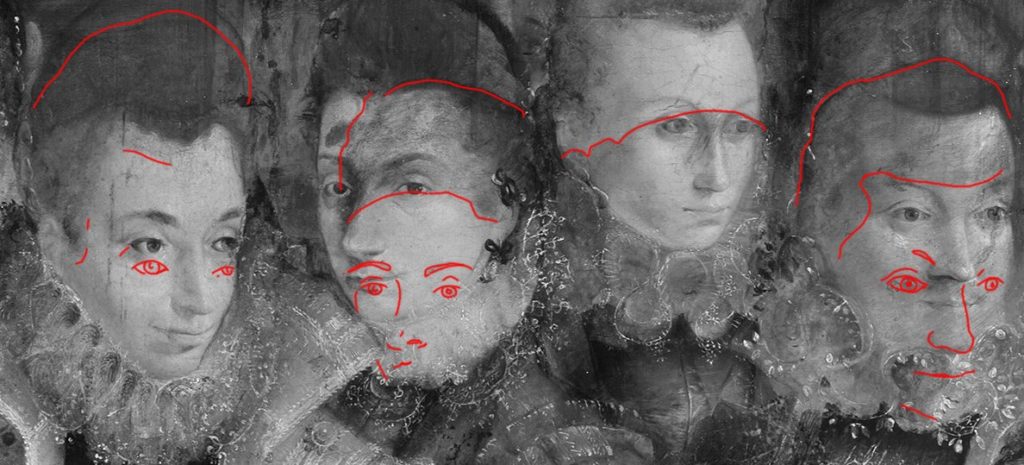
Our conservation department have demonstrated through examination of Fontana’s paint layers that large portions of the composition were revised multiple times, and technical imaging reveals a plethora of major pentimenti scattered across the canvas. (The drastic repositioning of the faces of the queen’s ladies in waiting, for example, is visible as a series of ghostly eyes floating across the infrared reflectograph which reveal that Fontana brought the faces to near completion before painting over them and repositioning them at a higher level.)
Examination of the various strata beneath these areas of change suggests that there were considerable periods of time separating her revisions, and that she worked on the painting over several years before completing it. An inscription on a clock applied on the uppermost layer of paint as a final flourish and revealed during cleaning provides, for the first time, a terminus ante quem for Fontana’s mysterious painting.
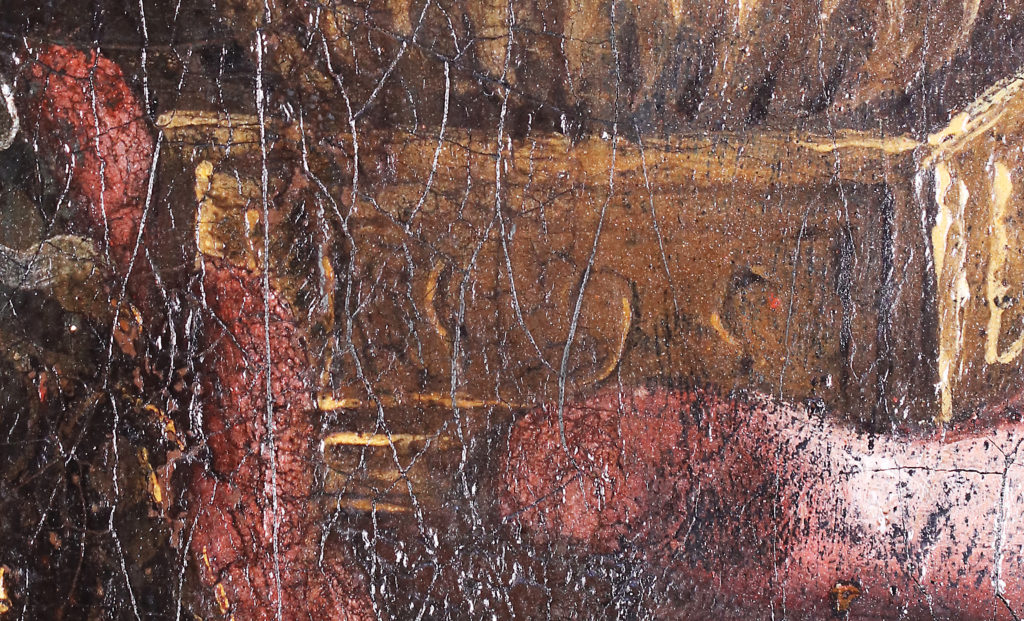
It is our belief now that Fontana started the painting many years prior to 1599, and that, in fact, it never left her studio. If indeed the painting is a portrait of Alfonso II d’Este and Margherita Gonzaga, such a completion date for this painting may explain why it does not appear in any court records of the time. Alfonso died, without an heir, in 1597, and with him the Duchy of Ferrara collapsed, thereby rendering this large canvas defunct. It seems plausible that the work remained in Fontana’s workshop until her departure for Rome around 1603, having been the subject of experimentation and endless revisions, and later assimilated into the neighbouring Zambeccari collection by unknown means.
A Manifesto of Fontana’s Abilities
We may never fully understand the origins of this multifaceted work, and further research is required to answer outstanding questions with certainty. Whatever the truth of its origins may be, the painting today can be viewed as a manifesto of Fontana’s abilities as an artist. From fantastical landscapes to portraits of male and female sitters, animals, and people with unique physical attributes, this painting illustrates Fontana’s mastery across multiple genres.
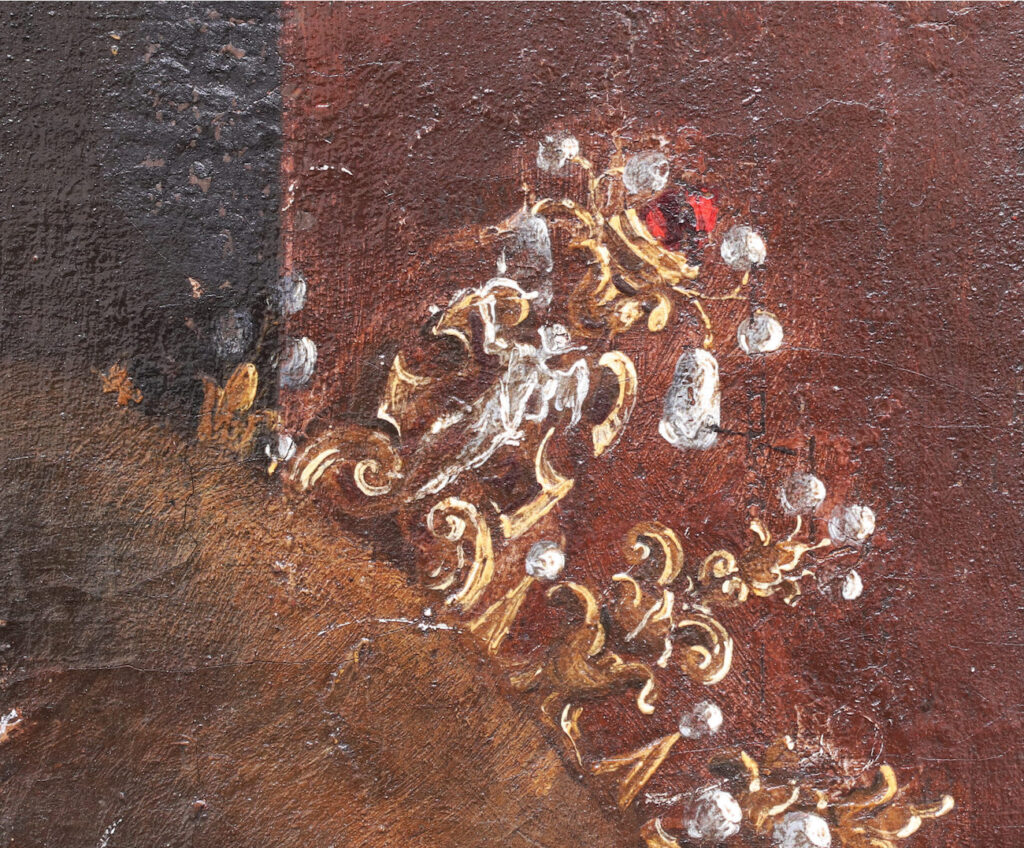
Meticulously rendered jewels and ornaments show her as an expert still-life painter, while the incredibly ornate embroidered fabrics became a hallmark for which she was famous. The work presents Fontana as an educated artist, demonstrating her ability to engage with both allegorical and biblical themes, and with traditions established by painters before her. It offers us a glimpse, all at once, of just what Lavinia Fontana could do.
Aoife Brady is the Curator of Italian and Spanish Art at the National Gallery of Ireland, Dublin. Aoife specialises in research on Bolognese painting, and on painting techniques, materials, and artists’ studio practices in seventeenth-century Italy and Spain. She holds a doctorate in the History of Art from Trinity College Dublin, and has previously held curatorial roles in the J. Paul Getty Museum, Los Angeles, and The National Gallery, London. Aoife is currently working on Lavinia Fontana: Trailblazer Rule Breaker, a large-scale exhibition of the artist’s work scheduled to open in Dublin on May 6, 2023.
More information on the research discussed here and conservation of The Visit of the Queen of Sheba to King Solomon can be found in a National Gallery of Ireland publication celebrating the project entitled The Crowning Glory: Lavinia Fontana’s Sheba and Solomon.
More Art Herstory blog posts about Lavinia Fontana:
Female Solidarity in Paintings of Judith and her Maidservant by Italian Women Artists, by Sivan Maoz
Stitching for Virtue: Lavinia Fontana, Elisabetta Sirani, and Textiles in Early Modern Bologna, by Dr. Patricia Rocco
Lavinia Fontana and Elisabetta Sirani at the Smith College Art Museum, by Dr. Danielle Carrabino
Lavinia Fontana: Italy’s First Female Professional Artist, Guest post by Dr. Elizabeth Lev
A Tale of Two Women Painters (Guest post / exhibition review by Natasha Moura)
Renaissance Women Painting Themselves, Guest post by Dr. Katherine McIver
The Art Herstory Lavinia Fontana Resource Page
Also of interest:
The National Gallery of Ireland Prioritizes the Acquisition of Art by Women
More Art Herstory blog posts about Italian women artists:
Plautilla Nelli and the Restoration of her Altarpiece Madonna del Rosario. by Jane Adams
Roma Pittrice: Women Artists at Work in Rome Between the Sixteenth and Nineteenth Centuries, by Alessandra Masu
Maddalena Corvina’s Saint Catherine of Alexandria, by Kali Schliewenz
Judith’s Challenge, from Lavinia Fontana to Artemisia Gentileschi, by Alessandra Masu
Plautilla Bricci: A Painter & “Architettrice” in Seventeenth-century Rome, by Alessandra Masu
Thoughts on Feminist Art History in the Wake of Artemisia: Vrouw & Macht at Rijksmuseum Twenthe, by Dr. Jitske Jasperse
Sister Eufrasia Burlamacchi (Lucca, 1478–1548), by Dr. Loretta Vandi
By Her Hand: Personal Thoughts and Reflections on an Exhibition, by Oliver Tostmann
Giovanna Garzoni’s Portrait of Zaga Christ (Ṣägga Krǝstos), by Dr. Alexandra Letvin
In defense of monographic exhibitions of female artists: The case of Fede Galizia, by Camille Nouhant
The Ladies of Art are in Milan, by Dr. Cecilia Gamberini
“Artemisia” at the National Gallery: A Review, by Dr. Sheila McTighe
Artemisia Gentileschi: What Wasn’t in the London Exhibition and Why it Matters, by Dr. Jesse Locker
“La grandezza del universo” nell’arte di Giovanna Garzoni / “The grandeur of the universe” in the art of Giovanna Garzoni, by Dr. Sara Matthews-Grieco
Sister Caterina Vigri (St. Catherine of Bologna) and “Drawing for Devotion,” Guest post by Dr. Kathleen G. Arthur
Two of a Kind: Giovanna Garzoni and Artemisia Gentileschi, by Dr. Mary D. Garrard
The Protofeminist Insects of Giovanna Garzoni and Maria Sibylla Merian, by Dr. Emma Steinkraus
Plautilla Bricci (1616–1705): A Talented Woman Architect in Baroque Rome, by Dr. Consuelo Lollobrigida
The Priceless Legacy of Artemisia Gentileschi: A Curator’s Perspective, by Dr. Judith W. Mann


